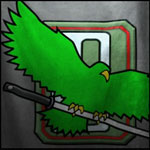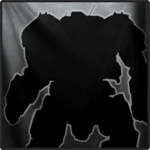I was messing around in the testing grounds trying to jump jet to strange places and such when I got to noticing how long it takes to destroy my own legs with falling damage. It made me think.
Why does the damage apply itself to my armor first? I am not hurting my armor by falling, I am damaging my structure. Shouldn't leg damage from falling apply to the internal structure of the Mech right off? Overheat damage applies to the internals and doesn't go through the CT armor, so why should this be different?
It might also make players think a bit before JJ'ing up to max height to get that shot off then plummeting back down to earth. Does anyone else think falling damage should bypass leg armor? Would add a little more value to the shock absorber module as well.

Fall Damage
Started by The Strange, Nov 15 2014 11:19 PM
6 replies to this topic
#1
Posted 15 November 2014 - 11:19 PM
#2
Posted 15 November 2014 - 11:22 PM
Well yea it should hit the structure. If I were to jump off a bridge my skin isn't ripped all the way up my legs first, my ******* legs snaps like a pretzel stick.
#3
Posted 15 November 2014 - 11:34 PM
How about no?
#4
Posted 15 November 2014 - 11:52 PM
6.1 Standard Armor
The first and outer-most layer is an extremely strong, extremely hard layer of steel. This layer fragments projectiles. It also ablates and conducts heat to provide protection from energy attacks. The crystalline structure of this steel is carefully aligned and radiation treated for maximum hardness and strength. Because of its phenomenal strength and hardness, the first layer suffers the trade off of being quite brittle - so brittle that the second layer of armor under it has to act as a backstop for shattered fragments of the outer layer.
The second and inner layer, cubic boron nitride (which is a very hard layer in its own right) is processed to avoid porosity, and includes a micro fiber web of man made diamond mono-filament fibers which imparts a little bit of flexibility to this second armor layer. The weave in this layer also incorporates sensor, data, and control lines This internal layer back-stops molten armor from the first layer, and armor from the first layer converted into plasma by heavy attack. It is this layer that stops High Explosive Armor Piercing (HEAP) rounds and fast neutrons.
The third layer - which is not an armor layer - is a titanium alloy honeycomb. This layer is used to support the outer armor layers. As it has already been said, the first and second armor layers are proportionally very thin and thus not load-bearing. Because of this it is the titanium honeycomb layer that holds the armor in place and (normally) keeps the brittle first and second armor layers from flexing.
However, when the outer layers are flexed too much, they will shatter like a pane of tempered glass... it is this tendency of the outer armor layers to shatter due to their extreme hardness that is one of the reasons why BattleMechs lose armor when they fall, suffer physical attacks from other BattleMechs, or collide with structures or other units. The comment about the difference between strength and stiffness from the description of Endo-steel applies here as well.
The last and innermost layer is a polymer sealant, which seals off the gaps between the individual armor plates, making a BattleMech air tight and water proof. The polymers used usually have some self-sealing capability (just enough to handle small punctures and gaps) and are heat resistant enough to survive the high internal temperatures of a BattleMech in combat. It is this sealing layer that allows a BattleMech to operate under water, in outer space or in other such extreme conditions.
TLDR - The stuff is like glass.
The first and outer-most layer is an extremely strong, extremely hard layer of steel. This layer fragments projectiles. It also ablates and conducts heat to provide protection from energy attacks. The crystalline structure of this steel is carefully aligned and radiation treated for maximum hardness and strength. Because of its phenomenal strength and hardness, the first layer suffers the trade off of being quite brittle - so brittle that the second layer of armor under it has to act as a backstop for shattered fragments of the outer layer.
The second and inner layer, cubic boron nitride (which is a very hard layer in its own right) is processed to avoid porosity, and includes a micro fiber web of man made diamond mono-filament fibers which imparts a little bit of flexibility to this second armor layer. The weave in this layer also incorporates sensor, data, and control lines This internal layer back-stops molten armor from the first layer, and armor from the first layer converted into plasma by heavy attack. It is this layer that stops High Explosive Armor Piercing (HEAP) rounds and fast neutrons.
The third layer - which is not an armor layer - is a titanium alloy honeycomb. This layer is used to support the outer armor layers. As it has already been said, the first and second armor layers are proportionally very thin and thus not load-bearing. Because of this it is the titanium honeycomb layer that holds the armor in place and (normally) keeps the brittle first and second armor layers from flexing.
However, when the outer layers are flexed too much, they will shatter like a pane of tempered glass... it is this tendency of the outer armor layers to shatter due to their extreme hardness that is one of the reasons why BattleMechs lose armor when they fall, suffer physical attacks from other BattleMechs, or collide with structures or other units. The comment about the difference between strength and stiffness from the description of Endo-steel applies here as well.
The last and innermost layer is a polymer sealant, which seals off the gaps between the individual armor plates, making a BattleMech air tight and water proof. The polymers used usually have some self-sealing capability (just enough to handle small punctures and gaps) and are heat resistant enough to survive the high internal temperatures of a BattleMech in combat. It is this sealing layer that allows a BattleMech to operate under water, in outer space or in other such extreme conditions.
TLDR - The stuff is like glass.
#5
Posted 16 November 2014 - 01:08 AM
uhm because there's a big difference between a metal leg and skin for one...
#6
Posted 16 November 2014 - 01:22 AM
Damaging structure from falls makes sense to me.
#7
Posted 16 November 2014 - 01:30 AM
Well, what mech were you in? the variables can be significantly different when dealing with your question.
And the devs have done an admirable job so far. I just wish that they do a better job at defining what they've done; and what they're looking to do in the future better; to better answer these questions!.
And the devs have done an admirable job so far. I just wish that they do a better job at defining what they've done; and what they're looking to do in the future better; to better answer these questions!.
1 user(s) are reading this topic
0 members, 1 guests, 0 anonymous users
























